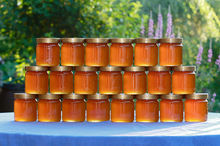Many health claims have been made about both Scottish heather honey and New Zealand manuka honey, as well as honeys from many other sources. According to scientists, the antibacterial activity of honey is well documented, this activity is mainly due to its low pH, osmolarity and hydrogen peroxide accumulation.

Honey as healer of horse wounds
The aim of this study was to investigate the antimicrobial activity of selected honeys from different origins; specifically to evaluate their non-hydrogen peroxide derived activity, against bacteria commonly found in horse wounds.
© 2013 by Waugsburg
Recently, more attention has been given to the importance of a unique extra antimicrobial activity, termed as a non-peroxide activity.
The aim of this study was to investigate the antimicrobial activity of selected honeys from different origins; specifically to evaluate their non-hydrogen peroxide derived activity, against Staphylococcus epidermidis, Bacillus sphaericus, Bacillus subtilis, Serratia marcescens, Escherichia coli and S. epidermidis found in horse wounds. Manuka honey was used as the control.
Antibacterial activity of the honeys was assayed using standard well diffusion methods. noticeable variations in the antibacterial activity of the different honey samples were observed.
Most of tested honeys had broad-spectrum antibacterial activity, particularly Greek Pine, Scottish Heather, Chilean Ulmo, New Zealand Beech and Jarrah Honey. Unfortunately, none of the tested honey had a detectable non-peroxide activity.
Scottish heather honey is made by bees that collect nectar from heather that blooms in August on the Highlands of Scotland. Like all honeys, heather honey has anti-bacterial properties which makes it a good natural remedy for wounds and cuts.
However, a couple of British newspapers recently published articles boldly claiming that Scottish heather honey is in fact the best honey for killing bacteria, even better than the highly-praised – and highly-priced – manuka honey. These claims are based on the study published in The Veterinary Journal in 2013 which tested eleven kinds of honey for their ability to kill microbes.
In this study, the antimicrobial activities of the honey samples were assessed against 10 bacteria recovered from wounds of horses. These bacteria included methicillin-resistant Staphylococcus aureus (MRSA) and Pseudomonas aeruginosa, two pathogenic microbes that have been linked to several difficult-to-treat infections in humans.
Eight of the ten tested products were effective against all 10 bacteria at concentrations varying from <2% to 16% (v/v).
Scottish heather honey, which showed the strongest anti-bacterial action among the tested products, inhibited the growth of all pathogenic bacteria even at low concentrations. In this study, Scottish heather honey performed even better than manuka honey.
But there's a catch: heather honey's activity comes almost exclusively from hydrogen peroxide, a naturally-occurring chemical that is produced by certain enzymes present in honey. Unfortunately, these enzymes are easily destroyed by heat, light, and body fluids.
Manuka honey, by contrast, gets most of its anti-bacterial power from a compound called methylglyoxal, or MGO. This microbe-killing compound is highly resistant to heat and light and thus considered extremely stable.
Furthermore, a study from 2012 suggests that manuka honeys that contain exceptionally high levels of MGO may in fact have stronger anti-bacterial properties than Scottish heather honey. This study found that all tested high-MGO manuka honeys had stronger total anti-bacterial activity than Scottish heather honey.
Also Greek pine honey was found to have more microbe-killing power than heather honey.
However, heather honey did beat all other honeys included in this study, including Australian eucalyptus honey, Yorkshire honey, New Zealand beech honey, Spanish orange blossom honey, and a handful of other common and some less common honeys.
The bottom line when it comes to healing power of honey
Both New Zealand manuka and Scottish heather honey have very strong anti-bacterial properties, and both have earned their reputations as healing super foods. However, there's no clear answer to the question 'which one is better in terms of antibacterial and healing power' as things like processing methods and storage conditions can cause significant variations in the anti-bacterial properties of these two kinds of honey.
Furthermore, due to the significant differences in the MGO content, some manuka honeys are much more effective at killing microbes than others. Manuka honeys with high levels of MGO are usually labelled as "UMF Manuka Honey" or "Active Manuka Honey".
